Butterflies and Moths
Media

Species Types
Scientific Name
More than 700 species in North America north of Mexico
Description
Learn about butterflies and skippers as a group. What makes a butterfly a butterfly? How are they different from moths? What are the major groups of butterflies?
Media

Species Types
Scientific Name
Phyciodes tharos
Description
Don't let the pearl crescent’s dainty size keep you from admiring its intricate beauty.
Media

Species Types
Scientific Name
Pontia protodice
Description
The checkered white is named for the charcoal-colored patterns on the white wings of adults. As with the closely related cabbage white, the larvae feed on plants in the mustard family.
Media
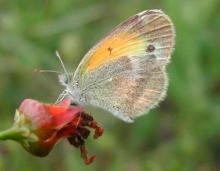
Species Types
Scientific Name
Nathalis iole
Description
Each year, dainty sulphurs arrive in Missouri from regions to our south. They are small compared to other sulphur butterflies. The wingspan of the largest individuals reaches only about 1¼ inches.
Media
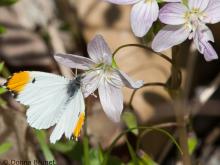
Species Types
Scientific Name
Anthocharis midea
Description
Falcate orangetip males are unmistakable with their small size, white coloration, and orange wingtips. Look for them in open woodlands in April.
Media

Species Types
Scientific Name
Pyrisitia lisa (syn. Eurema lisa)
Description
The little yellow is just what the name says it is. The lower side is yellow with a few spots, including two tiny black spots on the basal hindwing and, often, a larger rusty spot on the hindwing margin.
Media
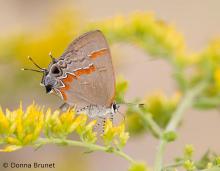
Species Types
Scientific Name
Calycopis cecrops
Description
The red-banded hairstreak has a unique pattern of white, black, and red-orange bands on the underside hindwing. It is most common in the Ozarks.
Media
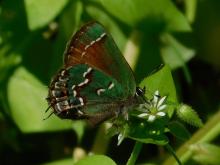
Species Types
Scientific Name
Callophrys gryneus gryneus (syn. Mitoura gryneus gryneus)
Description
The only green butterfly in Missouri, the olive (or juniper) hairstreak never strays far from eastern red cedar, its larval food plant. Adults fly between April and August.
Media
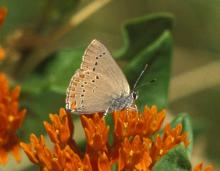
Species Types
Scientific Name
Satyrium titus (syn. Harkenclenus titus)
Description
The coral hairstreak is the only Missouri hairstreak lacking hindwing “tails” and without a blue spot on the outer hindwing edge.
Media
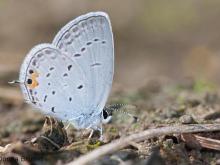
Species Types
Scientific Name
Cupido comyntas
Description
You can find the eastern tailed-blue in Missouri in prairies, fields, vacant lots, and yards — virtually any open, sunny place.
See Also


Media

Species Types
Scientific Name
About 1,500 species in North America north of Mexico
Description
Adult caddisflies are mothlike. Their larvae are aquatic and build portable, protective cases out of local materials, including grains of sand, bits of leaves and twigs, and other debris.
Media

Species Types
Scientific Name
Corydalus cornutus
Description
Adult eastern dobsonflies are huge and mothlike, with large wings and a weak, fluttery flight. The fiercely predaceous aquatic larvae, called hellgrammites, are well-known to anglers, who often use them as bait.
About Butterflies and Moths in Missouri
Butterflies, skippers, and moths belong to an insect order called the Lepidoptera — the "scale-winged" insects. These living jewels have tiny, overlapping scales that cover their wings like shingles. The scales, whether muted or colorful, seem dusty if they rub off on your fingers. Many butterflies and moths are associated with particular types of food plants, which their caterpillars must eat in order to survive.





















